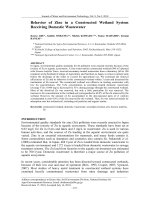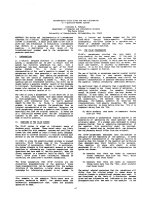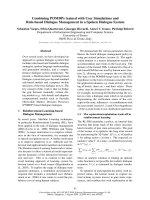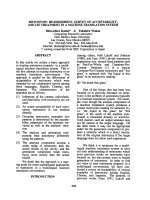Oxytetracycline residues in a freshwater recirculating system
Bạn đang xem bản rút gọn của tài liệu. Xem và tải ngay bản đầy đủ của tài liệu tại đây (162.65 KB, 10 trang )
Aquaculture 205 (2002) 221 – 230
www.elsevier.com/locate/aqua-online
Oxytetracycline residues in a freshwater
recirculating system
Julie Bebak-Williams a,*, Graham Bullock a, Mary C. Carson b
b
a
Freshwater Institute, P.O. Box 1889, Shepherdstown, WV 25443, USA
Division of Residue Chemistry, U.S. Food and Drug Administration, Center for Veterinary Medicine, 8401
Muirkirk Road, Laurel, MD 20708, USA
Received 7 March 2001; accepted 1 June 2001
Abstract
When oxytetracycline (OTC) medicated feed is fed to fish in a recirculating aquaculture system,
antibiotic residues could accumulate in fish tissue, water, biofilter sand and sediment to a greater
extent than in single pass or serial reuse aquaculture systems. In two trials, oxytetracyclinemedicated feed (3 g active ingredient per pound of feed) was fed to adult rainbow trout at 1% b.w.
per day for 10 days. OTC residues were assayed in fish muscle (with skin attached), water, sediment
(e.g., fish feces, uneaten feed) and biofilter sand. For both trials, oxytetracycline was detected during
the 10 days of treatment in all matrices assayed. In trout muscle, OTC concentrations increased to an
average of 1.8 mg/g by day 10 of treatment and then declined to < 0.2 mg/g by 21 days posttreatment. For water entering and exiting the biofilter, OTC concentrations increased to 0.5 mg/ml by
day 10 and was not detectable ( < 0.001 mg/ml) by 21 days post-treatment. For biofilter sand, OTC
concentration was approximately 14 mg/g by day 10 and decreased to < 2 mg/g by 21 days posttreatment. In sediment samples, OTC concentrations increased to 1900 mg/g by day 10 and declined
to < 2 mg/g by 21 days post-treatment. In this system, OTC concentrations in trout muscle were well
below 2 mg/g by 21 days after withdrawal of the drug. After input of medicated feed to the system
was stopped, OTC concentrations in water, sediment and the biofilter declined and did not increase
during the post-treatment period.
D 2002 Elsevier Science B.V. Open access under CC BY-NC-ND license.
Keywords: Oxytetracycline; Residues; Recirculating system; Rainbow trout; Antibiotics
*
Corresponding author. Tel.: +1-304-876-2815; fax: +1-304-870-2208.
E-mail address: (J. Bebak-Williams).
0044-8486 D 2002 Elsevier Science B.V. Open access under CC BY-NC-ND license.
PII: S 0 0 4 4 - 8 4 8 6 ( 0 1 ) 0 0 6 9 0 - 1
222
J. Bebak-Williams et al. / Aquaculture 205 (2002) 221–230
1. Introduction
Recirculating aquaculture systems for finfish production use new water input to result
in as little as one to two complete system turnovers per day. Oxytetracycline (OTC)
medicated feed is used to treat systemic bacterial infections affecting fish reared in these
systems. The fate of OTC under recirculating conditions is unknown and residue depletion
rates could differ from single pass, serial reuse and net pen systems. It is unlikely that OTC
will accumulate and persist in muscle of fish reared in recirculating systems. OTC is
poorly absorbed in fish muscle and, at 12 °C, concentrations have been demonstrated to be
below 1 mg/g by 14 days after drug withdrawal (Herman et al., 1969; Cravedi et al., 1987;
Bjorklund and Bylund, 1990; Bjorklund et al., 1990, 1991). However, oxytetracycline
chelates divalent cations and binds readily to sediments (Jacobsen and Berglind, 1988;
Lunestad and Goksoyr, 1990) so it is more likely to accumulate in system water, biofilter
sand and sediment (fish feces and uneaten feed). The purpose of this study was to
determine if OTC would accumulate in fish muscle (with skin attached), tank water,
biofilter sand and sediment (fish feces and uneaten feed) under conditions of recirculating
system culture.
2. Materials and methods
2.1. Study systems
Two identical side-by-side recirculating systems, A and B, were used for Trial 1 and
Trial 2, respectively (Schwartz et al., 2000). For each system, water flowed from a 1500-l
culture tank, through a drum filter, to a sump, from where it was pumped into six
identical fluidized sand biofilters before reentering the tank. The make-up flow, a hard
spring water (300 mg/kg as CaCO3) at 11.5 °C, was added at 3 l/min, a rate of 5% of the
system flow, to provide approximately two system volume turnovers per day. Sediment
(fish feces and uneaten feed) was removed from the system by cleaning it from the pump
sump and drum filter. The physical set-up of these unit processes precluded estimation of
the total amount of sediment removed from the system. During Trial 1, sediment was
removed on days 0, 2, 6, 10, 13, 17, 21, 23, 27, 29, 32, 34, 36, 38 and 41. During Trial 2,
sediment was removed on days 1, 3, 6, 8, 10, 14, 17, 20, 22, 24, 27, 29 and 31. If
sediment was removed on the sampling day, the sample was taken before the sediment
was removed.
2.2. Rainbow trout
For Trial 1, 192 adult rainbow trout, average b.w. 0.562 kg, were stocked at a density of
60.9 kg/m3 (total weight of fish stocked = 108 kg). For Trial 2, 175 trout, average b.w.
0.548 kg, were stocked at a density of 64.0 kg/m3 adult rainbow trout (total weight of fish
stocked = 96.0 kg). Fish were acclimated for 14 days before starting each trial. Dead fish
were removed daily.
J. Bebak-Williams et al. / Aquaculture 205 (2002) 221–230
223
2.3. Feed
All feed was hand-fed, three times per day, at 1% b.w. per day. The unmedicated
feed was 3/16U Trout Grower HE (42:15), Ziegler Brothers, Gardners, PA. The
oxytetracycline-medicated feed, which was fed for the first 10 days of each trial, was
3/16U Trout Grower HE with Terramycin-100 at 3 g active ingredient (OTC-HCl) per
pound of feed (6.6 g OTC-HCl/kg; OTC concentration 6.1 g/kg) (Ziegler Brothers).
Medicated feed was used within 2 weeks of manufacture. Two samples from medicated
and unmedicated feed were sent to commercial laboratories for analysis of oxytetracycline concentration.
2.4. Sampling schedule and methods
Trial 1 was conducted from May 11, 1999 to June 20, 1999. Trial 2 was conducted
from September 28, 1999 to October 29, 1999. Fish muscle (with skin attached), water
(entering and exiting the biofilter), biofilter sand and sediment (fish feces, uneaten feed)
were sampled. During the first trial, two samples of each of the five matrices were taken
at days 0, 2, 4, 6, 8, 10, 15, 20, 31 and 40. For the second trial, samples were collected at
days 0, 5, 10, 20, and 31. Using data from the first trial, sample sizes were estimated for
matrices collected during Trial 2. These sample sizes were chosen to reduce the
coefficient of variation around the mean to < 0.25. For the second trial, seven trout,
six water (three before and three after the biofilter), three sand and four sediment samples
were taken.
Trout were sampled by removing fish from tank, stunning fish with a blow to the
head, filleting fish with skin attached to muscle and freezing both fillets for analysis.
Water was sampled by filling a 50-ml polypropylene centrifuge tube. Biofilter sand was
collected from the six biofilters, combined together, subsampled and put in a 50-ml
polypropylene centrifuge tube. Each sediment sample was collected in a 1-mm mesh net,
drained and then put in a 50-ml polypropylene centrifuge tube. Fish samples were frozen
at À 80 °C. Other matrices were frozen at À 20 °C. Samples were shipped on freezer
blocks for analysis at the Division of Residue Chemistry. All samples were assayed
within 35 days of collection.
2.5. Analytical methods for OTC residues
OTC was determined in all matrices by reversed-phase liquid chromatography on a
˚ , 5 mm), with UV
polymeric column (Polymer Labs PLRP-S, 4.6 Â 150 mm, 100 A
detection at 350 nm. The mobile phase was a gradient from 100% solvent A (0.1%
trifluoroacetic acid (TFA) in water) to 70% solvent B (0.1% TFA in acetonitrile).
Injection volume varied with matrix: 500 ml for water and sand extracts, 200 ml for trout
extracts, and 50 ml for sediment extracts. All extracts were filtered through 0.2 or 0.45
mm PVDF filters prior to analysis. Quantitation was by comparison to a multipoint
external standard curve prepared in the same buffer as the final sample extract.
Water was prepared for analysis by dilution with an equal volume of MCIlvaine/EDTA
buffer (Cuniff, 1999, Method 995.09).
224
J. Bebak-Williams et al. / Aquaculture 205 (2002) 221–230
Biofilter sand was prepared by shaking 1 g of sample with 25 ml 0.1 N HCl for 30 –45
min, followed by centrifugation.
Sediment was prepared by homogenizing (Polytron) 2 g of sample with 25 ml
McIlvaine/EDTA buffer, shaking for 2 h, and centrifugation. For samples where the
expected OTC concentration exceeded 100 mg/g, an aliquot of the extract was diluted 100fold with McIlvaine/EDTA buffer.
Trout fillets were prepared by grinding with dry ice to a homogenous powder (Bunch et
al., 1995). After sublimation of the carbon dioxide, 5 g of ground tissue was homogenized
with a total of 25 ml McIlvaine/EDTA buffer (MacNeil et al., 1996), shaken for 30 –45
min, and centrifuged. The pellet was re-extracted with buffer, centrifuged, and the
supernate combined with the first extract. A portion of the tissue extract was further
cleaned and OTC concentrated from it by passage through Oasis HLB (Waters) solidphase extraction cartridges.
3. Results
3.1. Analytical methods
Prior to initiation of Trial 1, the analytical methods were validated by analysis of
replicate (generally n = 5) samples of fortified control matrix. Each matrix was fortified at
four or more concentrations. The fortification concentrations ranged from the highest level
expected to be encountered in the study to below the anticipated method limit of
quantitation. The actual limit of quantitation was defined as the lowest fortification level
which met acceptance criteria for accuracy (average recovery between 80% and 110%) and
precision (relative std. dev. < 20%). The lower limit of detection (estimated from matrix
background noise), limit of quantitation, and upper limit of validation for each of these
four matrices were 0.04, 0.05, and 4.0 mg/g (trout); 0.03, 0.1, and 20 mg/g (biofilter sand);
1, 10 and 6000 mg/g (sediment); and 0.001, 0.01 and 10 mg/ml (water). Recovery and
precision for samples fortified at and above the method limit of quantitation are
summarized in Table 1.
3.2. Tank environment conditions
During Trial 1, system water temperature was 14.3 F 0.6 °C and pH range was 7.07 to
7.22. During Trial 2, system water temperature was 14.1 F 0.8 °C and pH range was 7.19
to 7.46.
Table 1
Fortification range, average % recovery and % CV for analysis of each matrix
Matrix
Fortification range (mg/g)
Average % recovery
% CV
Trout
Tank Water
Sediment
Biofilter Sand
0.05 – 4
0.01 – 10
10 – 6000
0.1 – 20
84 – 102
87 – 89
82 – 106
92 – 108
3–4
3 – 16
4 – 20
2 – 13
J. Bebak-Williams et al. / Aquaculture 205 (2002) 221–230
225
3.3. Oxytetracycline in feed
For Trial 1, oxytetracycline concentration in medicated and unmedicated feed was
assayed within 2 weeks of the manufacture date (New Jersey Feed Laboratory, Trenton,
NJ). OTC concentration in two subsamples of medicated feed was 6.2 g OTC-HCl/kg
and 6.0 g OTC-HCl/kg (Cuniff, 1999). For unmedicated feed, OTC was measured at 21
and 18 mg/kg (Sakaguchi method, 42.188– 42.190 AOAC Manual (1975)). For Trial 2,
feed samples were analyzed about 3 months after the manufacture date (Woodson-Tenant
Laboratories, Memphis, TN). At that time, the OTC was measured in medicated feed at 6.2
and 5.5 g OTC-HCl/kg. In unmedicated feed, it was measured at < 10 mg/kg for both
samples (Cuniff, 1999).
3.4. Feed response, medicated feed fed, fish mortality
Throughout both trials, feeding response was good. A total of 9.13 kg of medicated
feed was fed during Trial 1, and 9.6 kg of medicated feed was fed during trial 2. So, for
Trial 1, at 6.1 g OTC-HCl/kg, 51 g OTC (free base) would have been added to the
system. For Trial 2, at 5.8 g OTC-HCl/kg, 51 g OTC would have been added to the
system.
There was no mortality during either trial except that four fish jumped from the tank
during Trial 1 and one fish jumped from the tank during Trial 2.
Fig. 1. Average concentration (mg/g) of oxytetracycline in trout muscle and skin and time (day) since the start of
medicated feed (. = Trial 1; E = Trial 2).
226
J. Bebak-Williams et al. / Aquaculture 205 (2002) 221–230
Fig. 2. Average concentration of oxytetracycline in tank water (mg/ml) and time (day) since the start of medicated
feed. Sample A was taken before water entered biofilter. Sample B was taken after water exited the biofilter
(. = Trial 1; E = Trial 2).
3.5. Oxytetracycline in matrices
For both trials, for all matrices, oxytetracycline concentration was below the limit of
detection on day 0, before the start of medicated feed.
3.5.1. Trout
In trout, for the two trials combined, OTC concentrations increased to an average of
1.82 mg/g by 10 days of treatment, was 0.33 mg/g by 10 days post-treatment and was 0.13
mg/g by 21 days post-treatment (Fig. 1, day 31 of Trial 1).
3.5.2. Water
For tank water from either source, OTC reached peak concentrations of 0.39 –0.72
mg/ml by 10 days of treatment and was at or below the limit of detection (0.001 mg/g) by
10 days post-treatment (Fig. 2).
3.5.3. Sand
For biofilter sand, OTC concentration increased to an average of 13.7 mg/g for both
trials combined by 10 days of treatment. OTC concentration was an average of 2.48
mg/g by 10 days post-treatment and decreased to 1.2 mg/g by 21 days post-treatment
(Fig. 3).
J. Bebak-Williams et al. / Aquaculture 205 (2002) 221–230
227
Fig. 3. Average concentration of oxytetracycline in biofilter sand (mg/g) and time (day) since the start of
medicated feed (. = Trial 1; E = Trial 2).
3.5.4. Sediment
In sediment samples, OTC concentration peaked at 2150 mg/g by day 4 of treatment
during Trial 1 and peaked at 1770 mg/g by day 10 of Trial 2 (Fig. 4). After medicated feed
was stopped, OTC concentration declined to 22 mg/g by 5 days post-treatment in Trial 1
and averaged 4.8 mg/g on 10 days post-treatment in both trials.
Fig. 4. Average concentration of oxytetracycline in sediment (mg/g) and time (day) since the start of medicated
feed (. = Trial 1; E = Trial 2).
228
J. Bebak-Williams et al. / Aquaculture 205 (2002) 221–230
4. Discussion
During both trials, oxytetracycline was detected during the 10 days of treatment in all
matrices assayed. During treatment, concentrations gradually increased. After input of
medicated feed to the system was stopped, OTC concentrations in trout, water, sediment
and biofilter sand declined quickly, and did not increase again.
4.1. OTC in fish muscle
In the United States, Food and Drug Administration (FDA) regulations for use of oxytetracycline in finfish culture specify treatment at 2.5 to 3.75 g per 100 lb (55 to 83 mg/kg)
fish per day for 10 days with a 21-day withdrawal prior to slaughter for food (21 CFR
§558.450). After 21 days, OTC concentrations must be below the tolerance of 2 ppm
(mg/g) (21 CFR §556.500). At the time the depletion data supporting the 21-day withdrawal were collected, trout were primarily raised in raceway systems. We found that,
under recirculating system conditions, the OTC concentration increased in trout during the
10 days of treatment, declined after the medicated feed was stopped and was well below
2 mg/g by the end of the 21 days withdrawal period.
The peak (last day of medicated feed) concentrations of OTC in fish muscle were
comparable to other studies carried out in farmed fish. Bjorklund and Bylund (1990)
found peak OTC concentrations of 0.6– 1.5 mg/g in farmed rainbow trout and salmon.
In rainbow trout, peak concentrations were 0.8 to 1.0 mg/g OTC in fish from two
farms that were treated with 85 or 110 mg/kg of the antibiotic (Bjorklund et al.,
1991).
4.2. OTC in water
In this study, OTC concentrations in water averaged 0.51 mg/ml during peak days 5
through 10 of treatment. Throughout the treatment period, the systems were discharging
3 l/min in the effluent. Consequently, during peak concentrations of OTC in the system,
2.2 g could be discharged per day, much less than the amount discharged by a flowthrough system (Smith et al., 1994).
4.3. OTC in sand
Concentrations of OTC in water were identical before and after the sand biofilter. The
OTC assayed from the biofilter could have been absorbed to organic particles on the
biofilter sand. Alternatively, the relatively poor adsorption of OTC to sand could have
been due to the range of sand particle size used in the biofilter. The peak concentration of
14 mg/g OTC in biofilter sand was consistent with Pouliquen et al. (1996), who studied the
sorption of OTC to sand, mud and sandy mud. In their study, the sand poorly adsorbed
OTC compared to the other two matrices. The authors concluded that the lower adsorption
occurred, in part, because fewer numbers of particles were < 63 mm in diameter. In this
study, the finest 10% of the biofilter sand was greater than 63 mm in diameter, with a
diameter of 170 mm (Schwartz et al., 2000).
J. Bebak-Williams et al. / Aquaculture 205 (2002) 221–230
229
4.4. OTC in sediment
Absorption of OTC in rainbow trout can be as low as 7– 9%, presumably because the
OTC binds to the dietary calcium and magnesium. Therefore, a major portion of the OTC
administered to farmed salmonids can end up in the environment (Lunestad and Goksoyr,
1990). Indeed, Smith et al. (1994) demonstrated that the quasi-totality of the OTC
administered to Atlantic salmon pre-smolts on a freshwater farm was detected in the
hatchery effluent. This low absorption of OTC is reflected in the high concentration of
OTC that was found in sediment in this study. In Trial 1, fish were fed 1.08 kg of
medicated feed per day, which is equivalent to a total of 5.6 g OTC per day. The OTC in
sediment increased from 0 to 710 mg/g from day 0 to day 2, which could reflect mostly
uneaten feed (Fig. 4). The sediment was cleaned from the system at day 2. Between day 2
and day 4, OTC concentration in the sediment increased from 710 to 2060 mg/g, reflecting
both uneaten feed and excretion of unabsorbed OTC in the feces. Concentrations then
remained at similar values until the last day of treatment.
During both trials, the systems were cleaned of sediment, thus removing OTC residues
that accumulated during the treatment period. The ability to remove, and dispose of,
sediments containing antibiotics is one advantage of the recirculating system. If OTC were
not removed, half-life in sediment can be as long as days to months in marine sediments
(Jacobsen and Berglind, 1988; Samuelsen, 1989; Bjorklund et al., 1990, 1991; Pouliquen
et al., 1992; Coyne et al., 1994; Hektoen et al., 1995). Recirculating systems should
incorporate an efficient solids removal system so that sediment containing antibiotics and
resistant bacteria (Samuelsen et al., 1992) can be removed and disposed of.
Acknowledgements
Thank you to Erik Burchard (Freshwater Institute) and Deepali Patel (FDA-CVM) for
providing technical assistance. Thank you to Dr. David Smith (USGS, Leetown Science
Center) for providing statistical advice. Thank you to the National Fish Health Research
Laboratory (USGS, Leetown, WV) for loan of the space for the recirculating systems. The
experimental protocol and methods described are in compliance with the Animal Welfare
Act (9CFR) requirements and are approved by the Freshwater Institute’s Institutional
Animal Care and Use Committee. This material is based upon work supported by the U.S.
Department of Agriculture, Agricultural Research Service, under Agreement No. 59-19308-038.
References
Bjorklund, H., Bylund, G., 1990. Temperature-related absorption and excretion of oxytetratcycline in rainbow
trout (Salmo gairdneri R.). Aquaculture 84, 363 – 372.
Bjorklund, H., Bondestam, J., Bylund, G., 1990. Residues of oxytetracycline in wild fish and sediments from fish
and farms. Aquaculture 86, 359 – 367.
Bjorklund, H.V., Rabergh, C.M.I., Bylund, G., 1991. Residues of oxolinic acid and oxytetracycline in fish and
sediments from fish farms. Aquaculture 97, 85 – 96.
230
J. Bebak-Williams et al. / Aquaculture 205 (2002) 221–230
Bunch, E.A., Altwein, D.M., Johnson, L.E., Farley, J.R., Hammersmith, A.A., 1995. Homogeneous sample
preparation of raw shrimp using dry ice. J. AOAC Int. 78, 883 – 887.
Coyne, R., Hiney, M., O’Connor, B., Kerry, J., Cazabon, D., Smith, P., 1994. Concentration and persistence of
oxytetracycline in sediments under a marine salmon farm. Aquaculture 123, 31 – 42.
Cravedi, J.-P., Choubert, G., Delous, G., 1987. Digestibility of chloramphenicol, oxolinic acid and oxytetracycline
in rainbow trout and influence of these antibiotics on lipid digestibility. Aquaculture 60, 133 – 141.
Cuniff, P. (Ed.), 1999. Official Methods of Analysis of AOAC International. AOAC International, Gaithersburg,
MD.
Hektoen, H., Berge, J.A., Hormazabal, V., Ynestad, M., 1995. Persistence of antibacterial agents in marine
sediments. Aquaculture 133, 175 – 184.
Herman, R.L., Collis, D., Bullock, G.L., 1969. Oxytetracycline residues in different tissues of trout. United States
Department of the Interior, Bureau of Sport Fisheries and Wildlife, Washington, D.C., pp. 1 – 6.
Jacobsen, P., Berglind, L., 1988. Persistence of oxytetracycline in sediments from fish farms. Aquaculture 70,
365 – 370.
Lunestad, B.T., Goksoyr, J., 1990. Reduction in the antibacterial effect of oxytetracycline in sea water by complex
formation with magnesium and calcium. Dis. Aquat. Org. 9, 67 – 72.
MacNeil, J.D., Martz, V.K., Korsrud, G.O., Salisbury, C.D.C., Oka, H., Epstein, R.L., Barnes, C.J., 1996.
Chlortetracycline, oxytetracycline, and tetracycline in edible animal tissues, liquid chromatographic method:
collaborative study. J. AOAC Int. 79, 405 – 417.
Pouliquen, H., Bris, H.L., Pinault, L., 1992. Experimental study of the therapeutic application of oxytetracycline,
its attenuation in sediment and sea water, and implications for farm culture of benthic organisms. Mar. Ecol.:
Prog. Ser. 89, 93 – 98.
Pouliquen, H., Bris, H., Bris, H.L., 1996. Sorption of oxolinic acid and oxytetracycline to marine sediments.
Chemosphere, vol. 33. Pergamon, Oxford, pp. 801 – 815.
Samuelsen, O.B., 1989. Degradation of oxytetracycline in seawater at two different temperatures and light
intensities and the persistence of oxytetracycline in the sediment from a fish farm. Aquaculture 83, 7 – 16.
Samuelsen, O.B., Torsvik, V., Ervik, A., 1992. Long-range changes in oxytetracyline concentration and bacterial
resistance towards oxytetracycline in a fish farm sediment after medication. Sci. Total Environ. 114, 25 – 36.
Schwartz, M.F., Bullock, G.L., Hankins, J.A., Summerfelt, S.T., Mathias, J.A., 2000. Effects of selected chemotherapeutants on nitrification in fluidized-sand biofilters for coldwater fish production. Int. J. Recirc. Aquacult. 1, 61 – 81.
Smith, P., Donlon, J., Coyne, R., Cazabon, D.J., 1994. Fate of oxytetracycline in a fresh water fish farm: influence
of effluent treatment systems. Aquaculture 120, 319 – 325.









